-
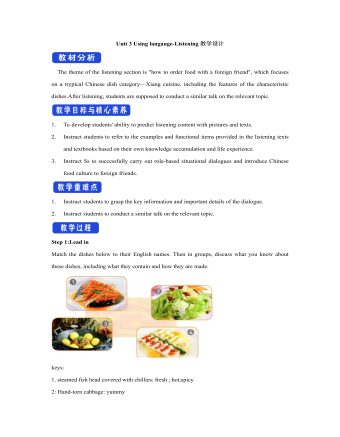
新人教版高中英语选修2Unit 3 Using langauge-Listening教学设计
1. How is Hunan cuisine somewhat different from Sichuan cuisine?The heat in Sichuan cuisine comes from chilies and Sichuan peppercorns. Human cuisine is often hotter and the heat comes from just chilies.2.What are the reasons why Hunan people like spicy food?Because they are a bold people. But many Chinese people think that hot food helps them overcome the effects of rainy or wet weather.3.Why do so many people love steamed fish head covered with chilies?People love it because the meat is quite tender and there are very few small bones.4.Why does Tingting recommend bridge tofu instead of dry pot duck with golden buns?Because bridge tofu has a lighter taste.5 .Why is red braised pork the most famous dish?Because Chairman Mao was from Hunan, and this was his favorite food.Step 5: Instruct students to make a short presentation to the class about your choice. Use the example and useful phrases below to help them.? In groups of three, discuss what types of restaurant you would like to take a foreign visitor to, and why. Then take turns role-playing taking your foreign guest to the restaurant you have chosen. One of you should act as the foreign guest, one as the Chinese host, and one as the waiter or waitress. You may start like this:? EXAMPLE? A: I really love spicy food, so what dish would you recommend?? B: I suggest Mapo tofu.? A: Really ? what's that?
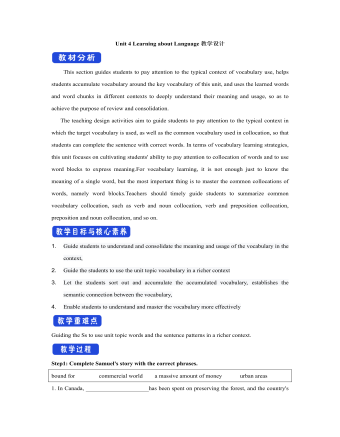
新人教版高中英语选修2Unit 4 Learning about Language教学设计
This section guides students to pay attention to the typical context of vocabulary use, helps students accumulate vocabulary around the key vocabulary of this unit, and uses the learned words and word chunks in different contexts to deeply understand their meaning and usage, so as to achieve the purpose of review and consolidation.The teaching design activities aim to guide students to pay attention to the typical context in which the target vocabulary is used, as well as the common vocabulary used in collocation, so that students can complete the sentence with correct words. In terms of vocabulary learning strategies, this unit focuses on cultivating students' ability to pay attention to collocation of words and to use word blocks to express meaning.For vocabulary learning, it is not enough just to know the meaning of a single word, but the most important thing is to master the common collocations of words, namely word blocks.Teachers should timely guide students to summarize common vocabulary collocation, such as verb and noun collocation, verb and preposition collocation, preposition and noun collocation, and so on.1. Guide students to understand and consolidate the meaning and usage of the vocabulary in the context, 2. Guide the students to use the unit topic vocabulary in a richer context3. Let the students sort out and accumulate the accumulated vocabulary, establishes the semantic connection between the vocabulary,4. Enable students to understand and master the vocabulary more effectivelyGuiding the Ss to use unit topic words and the sentence patterns in a richer context.
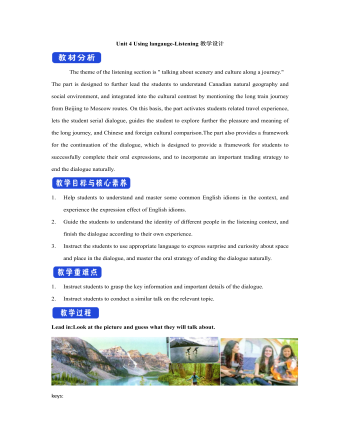
新人教版高中英语选修2Unit 4 Using langauge-Listening教学设计
The theme of the listening section is " talking about scenery and culture along a journey."The part is designed to further lead the students to understand Canadian natural geography and social environment, and integrated into the cultural contrast by mentioning the long train journey from Beijing to Moscow routes. On this basis, the part activates students related travel experience, lets the student serial dialogue, guides the student to explore further the pleasure and meaning of the long journey, and Chinese and foreign cultural comparison.The part also provides a framework for the continuation of the dialogue, which is designed to provide a framework for students to successfully complete their oral expressions, and to incorporate an important trading strategy to end the dialogue naturally.1. Help students to understand and master some common English idioms in the context, and experience the expression effect of English idioms.2. Guide the students to understand the identity of different people in the listening context, and finish the dialogue according to their own experience.3. Instruct the students to use appropriate language to express surprise and curiosity about space and place in the dialogue, and master the oral strategy of ending the dialogue naturally.1. Instruct students to grasp the key information and important details of the dialogue.2. Instruct students to conduct a similar talk on the relevant topic.
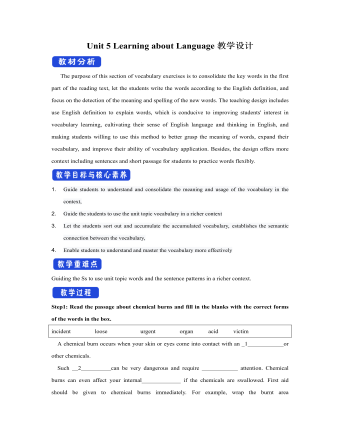
新人教版高中英语选修2Unit 5 Learning about Language教学设计
The purpose of this section of vocabulary exercises is to consolidate the key words in the first part of the reading text, let the students write the words according to the English definition, and focus on the detection of the meaning and spelling of the new words. The teaching design includes use English definition to explain words, which is conducive to improving students' interest in vocabulary learning, cultivating their sense of English language and thinking in English, and making students willing to use this method to better grasp the meaning of words, expand their vocabulary, and improve their ability of vocabulary application. Besides, the design offers more context including sentences and short passage for students to practice words flexibly.1. Guide students to understand and consolidate the meaning and usage of the vocabulary in the context, 2. Guide the students to use the unit topic vocabulary in a richer context3. Let the students sort out and accumulate the accumulated vocabulary, establishes the semantic connection between the vocabulary,4. Enable students to understand and master the vocabulary more effectivelyGuiding the Ss to use unit topic words and the sentence patterns in a richer context.Step1: Read the passage about chemical burns and fill in the blanks with the correct forms of the words in the box.
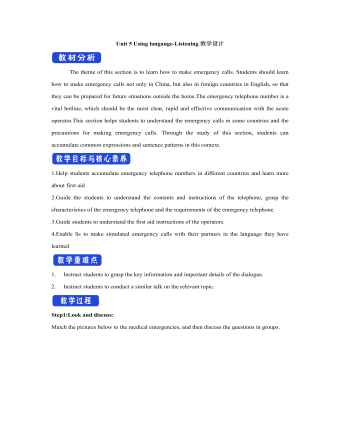
新人教版高中英语选修2Unit 5 Using langauge-Listening教学设计
The theme of this section is to learn how to make emergency calls. Students should learn how to make emergency calls not only in China, but also in foreign countries in English, so that they can be prepared for future situations outside the home.The emergency telephone number is a vital hotline, which should be the most clear, rapid and effective communication with the acute operator.This section helps students to understand the emergency calls in some countries and the precautions for making emergency calls. Through the study of this section, students can accumulate common expressions and sentence patterns in this context. 1.Help students accumulate emergency telephone numbers in different countries and learn more about first aid2.Guide the students to understand the contents and instructions of the telephone, grasp the characteristics of the emergency telephone and the requirements of the emergency telephone.3.Guide students to understand the first aid instructions of the operators.4.Enable Ss to make simulated emergency calls with their partners in the language they have learned1. Instruct students to grasp the key information and important details of the dialogue.2. Instruct students to conduct a similar talk on the relevant topic.Step1:Look and discuss:Match the pictures below to the medical emergencies, and then discuss the questions in groups.
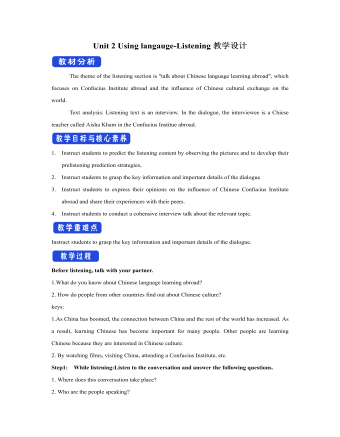
新人教版高中英语选修2Unit 2 Using langauge-Listening教学设计
? B: Absolutely! Getting involved with Chinese cultural activities there definitely helped a lot. I got to practice my Chinese on a daily basis, and I could learn how native Chinese speakers spoke.? A: What do you feel is your biggest achievement?? B: Learning Chinese characters! I have learnt about 1,500 so far. When I first started, I didn't think it was even going to be possible to learn so many, but now I find that I can read signs, menus, and even some easy newspaper articles.? A: What are you most keen on?? B: I've really become keen on learning more about the Chinese culture, in particular Chinese calligraphy. As I have learnt Chinese characters, I have developed a great appreciation for their meaning. I want to explore Chinese characters by learning how to write them in a more beautiful way. ? A: Finally, what do you want to say to anyone interested in learning Chinese?? I have really become keen on learning more about the Chinese culture, in particular Chinese Calligraphy. As I have learnt Chinese character, I have developed a great appreciation for their meaning. I want to explore Chinese characters by learning how to write them in a more beautiful way.? A: Finally, what do you want to say to anyone interested in learning Chinese?? B: I'd say, give it a shot! While some aspects may be difficult, it is quite rewarding and you will be happy that you tried.? A: Thanks for your time. ? B:You're welcome.
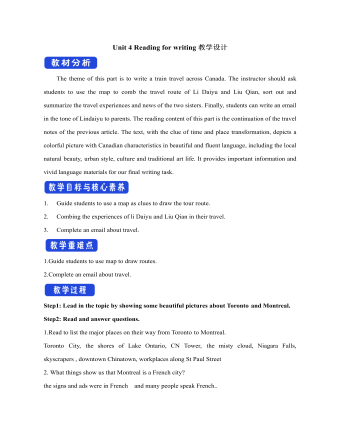
新人教版高中英语选修2Unit 4 Reading for writing教学设计
假定你是英国的Jack,打算来中国旅行,请你给你的中国笔友李华写一封信,要点如下:1.你的旅行计划:北京→泰山→杭州;2.征求建议并询问他是否愿意充当你的导游。注意:1.词数80左右(开头和结尾已给出,不计入总词数);2.可以适当增加细节,以使行文连贯。参考词汇:故宫 the Forbidden City;泰山 Mount TaiDear Li Hua,I'm glad to tell you that 'm going to visit China.First,I am planning to visit Beijing,the capitalof China,where I am looking forward to enjoying the Great Wall,the Forbidden City and somebeautiful parks.Then I intend to go to visit Mount Tai in Shandong Province.I've heard that it is one ofthe most famous mountains in China and I can't wait to enjoy the amazing sunrise there.After that,I amalso going to Hangzhou.It is said that it is a beautiful modern city with breathtaking natural sights,among which the West Lake is a well- known tourist attraction.What do you think of my travel plan? Will you act as my guide? Hope to hear from you soon.
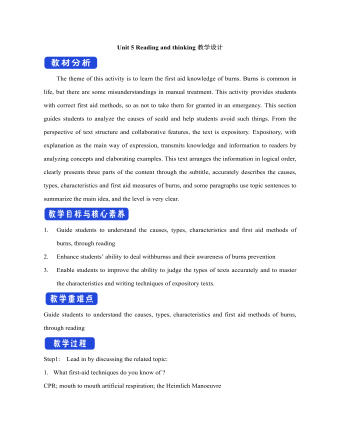
新人教版高中英语选修2Unit 5 Reading and thinking教学设计
The theme of this activity is to learn the first aid knowledge of burns. Burns is common in life, but there are some misunderstandings in manual treatment. This activity provides students with correct first aid methods, so as not to take them for granted in an emergency. This section guides students to analyze the causes of scald and help students avoid such things. From the perspective of text structure and collaborative features, the text is expository. Expository, with explanation as the main way of expression, transmits knowledge and information to readers by analyzing concepts and elaborating examples. This text arranges the information in logical order, clearly presents three parts of the content through the subtitle, accurately describes the causes, types, characteristics and first aid measures of burns, and some paragraphs use topic sentences to summarize the main idea, and the level is very clear.1. Guide students to understand the causes, types, characteristics and first aid methods of burns, through reading2. Enhance students’ ability to deal withburnss and their awareness of burns prevention3. Enable students to improve the ability to judge the types of texts accurately and to master the characteristics and writing techniques of expository texts.Guide students to understand the causes, types, characteristics and first aid methods of burns, through readingStep1: Lead in by discussing the related topic:1. What first-aid techniques do you know of ?CPR; mouth to mouth artificial respiration; the Heimlich Manoeuvre
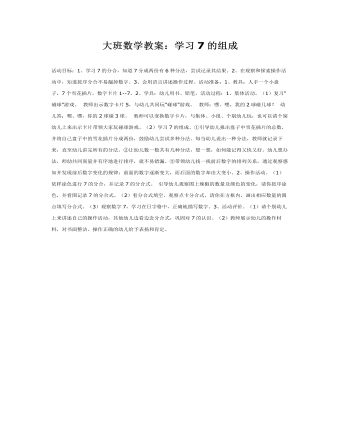
大班数学教案:学习7的组成
1、学习7的分合,知道7分成两份有6种分法,尝试记录其结果。2、在观察和探索操作活动中,知道按序分合不易漏掉数字。3、会用语言讲述操作过程。活动准备:1、教具:人手一个小盘子,7个雪花插片,数字卡片1--7。2、学具:幼儿用书、铅笔。活动过程:1、集体活动。(1)复习"碰球"游戏。 教师出示数字卡片5,与幼儿共同玩"碰球"游戏。 教师:嘿、嘿,我的2球碰几球? 幼儿答:嘿、嘿,你的2球碰3球。 教师可以变换数字卡片,与集体、小组、个别幼儿玩,也可以请个别幼儿上来出示卡片带领大家玩碰球游戏。(2)学习7的组成。①引导幼儿报出盘子中雪花插片的总数,并将自己盘子中的雪花插片分成两份,鼓励幼儿尝试多种分法。每当幼儿说出一种分法,教师就记录下来,直至幼儿讲完所有的分法。
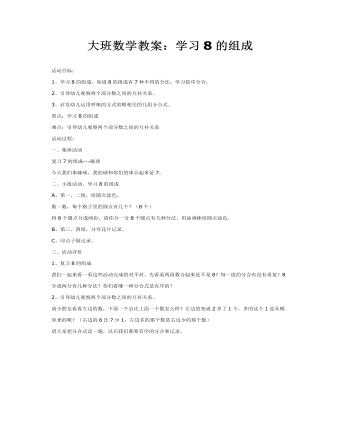
大班数学教案:学习8的组成
2、引导幼儿观察两个部分数之间的互补关系。3、启发幼儿运用呼唤的方式省略相关的几组分合式。重点:学习8的组成难点:引导幼儿观察两个部分数之间的互补关系活动过程:一、集体活动复习7的组成---碰球今天我们来碰球,我的球和你们的球合起来是7。
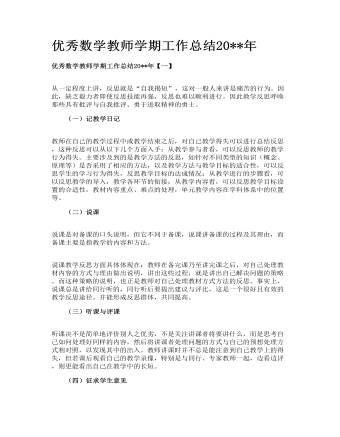
优秀数学教师学期工作总结
(一)记教学日记 教师在自己的教学过程中或教学结束之后,对自己教学得失可以进行总结反思,这种反思可以从以下几个方面入手:从教学参与者看,可以反思教师的教学行为得失。主要涉及到的是教学方法的反思,如针对不同类型的知识(概念、原理等)是否采用了相应的方法,以及教学方法与教学目标的适合性,可以反思学生的学习行为得失,反思教学目标的达成情况;从教学进行的步骤看,可以反思教学的导入,教学各环节的衔接;从教学内容看,可以反思教学目标设置的合适性,教材内容重点、难点的处理,单元教学内容在学科体系中的位置等。 (二)说课 说课是对备课的口头说明,但它不同于备课,说课讲备课的过程及其理由,而备课主要是指教学的内容和方法。 说课教学反思方面具体体现在:教师在备完课乃至讲完课之后,对自己处理教材内容的方式与理由做出说明,讲出这些过程,就是讲出自己解决问题的策略。而这种策略的说明,也正是教师对自己处理教材方式方法的反思。事实上,说课总是讲给同行听的,同行听后要提出建议与评比,这是一个很好且有效的教学反思途径。并能形成反思群体,共同提高。 (三)听课与评课 听课决不是简单地评价别人之优劣,不是关注讲课者将要讲什么,而是思考自己如何处理好同样的内容,然后将讲课者处理问题的方式与自己的预想处理方式相对照,以发现其中的出入。教师讲课时并不总是能注意到自己教学上的得失,但若课后观看自己的教学录像,特别是与同行、专家教师一起,边看边评,则更能看出自己在教学中的长短。
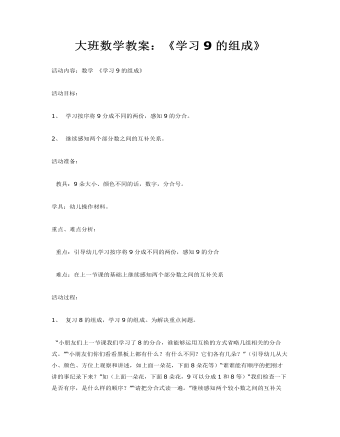
大班数学教案:《学习9的组成》
1、 学习按序将9分成不同的两份,感知9的分合。2、 继续感知两个部分数之间的互补关系。活动准备: 教具:9朵大小、颜色不同的话,数字,分合号。学具:幼儿操作材料。重点、难点分析: 重点:引导幼儿学习按序将9分成不同的两份,感知9的分合 难点:在上一节课的基础上继续感知两个部分数之间的互补关系
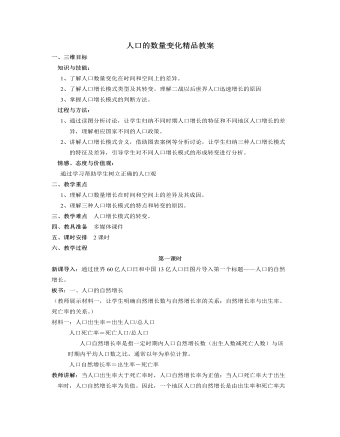
人教版高中地理必修2人口的数量变化精品教案
过渡:下面我们从时间角度分析世界人口数量变化的趋势是怎样的呢?为什么会这样呢?板书:1、人口自然增长的时间变化(引导学生读课本图1.2和图1.3,让学生分析)教师首先让学生说出阅读地理曲线统计图的一般步骤和方法,然后总结归纳:1、 读图名。2、 读各个坐标分别表示什么变量(两图横坐标均表示时间,纵坐标均为相应时期人口数)。3、 判读图形变化特征(两图中曲线曲率的变化反映对应时段内人口自然增长率的大小)。4、 思考变量之间的因果关系(两图均反映不同历史时期世界人口数量增长的不同特点)。问:世界人口数量变化的总趋势是什么?(让学生结合课本P2读图思考题,分析回答同时让学生阅读课本图1.3,在图1.2中找出图1.3所在的时段,指导学生自学P3第一段,让学生分析近100年全球人口快速增长的原因。最后师生共同归纳总结,填写下表。)
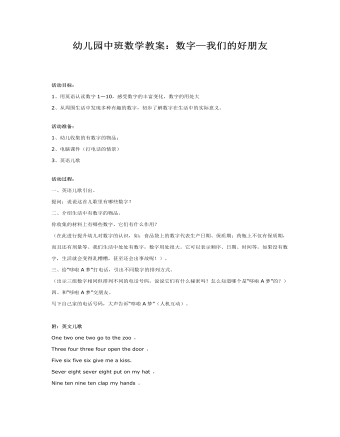
幼儿园中班数学教案:数字—我们的好朋友
2、从周围生活中发现多种有趣的数字,初步了解数字在生活中的实际意义。 活动准备: 1、幼儿收集的有数字的物品; 2、电脑课件(打电话的情景) 3、英语儿歌 活动过程: 一、英语儿歌引出。 提问:说说这首儿歌里有哪些数字? 二、介绍生活中有数字的物品。 你收集的材料上有哪些数字,它们有什么作用? (在此进行提升幼儿对数字的认识,如:食品袋上的数字代表生产日期、保质期;药瓶上不仅有保质期,而且还有剂量等。我们生活中处处有数字,数字用处很大。它可以表示顺序、日期、时间等。如果没有数字,生活就会变得乱糟糟,甚至还会出事故呢!)。
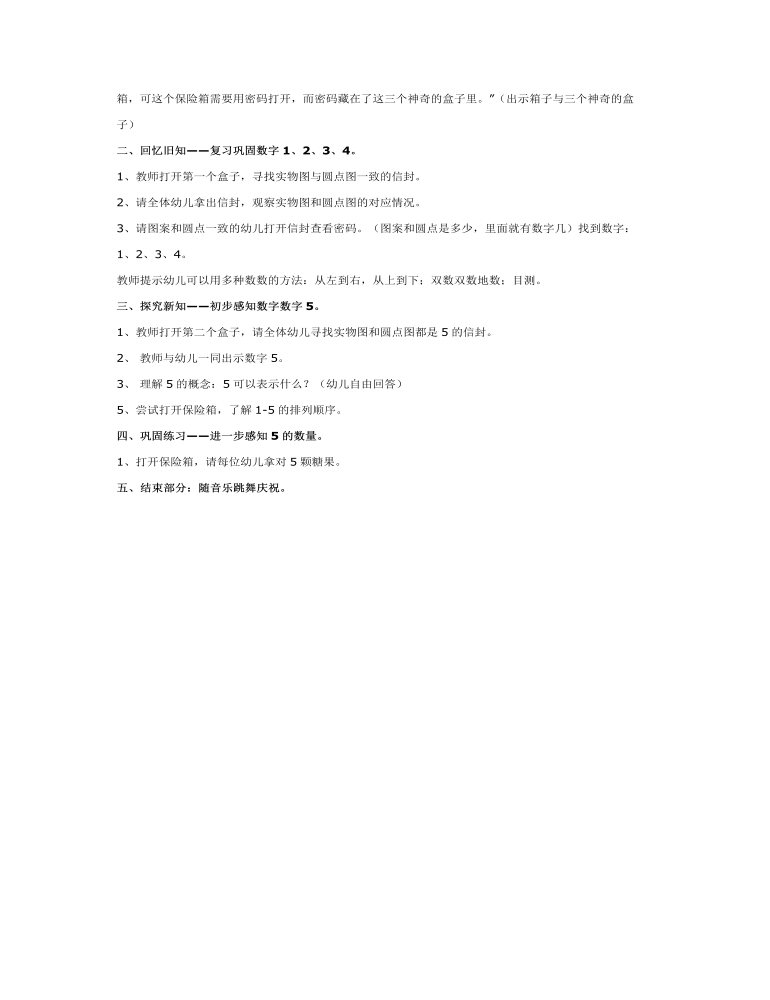
中班数学教案:破译密码——感知数字5
教学目标:1、通过游戏活动,初步理解5的概念,认识数字5。2、初步感受用不同方法来数数,并能按照一定的顺序来排列数。3、激发幼儿学习数学的兴趣,体验成功的喜悦,培养合作的意识。教学重点:通过游戏活动,初步理解5的概念,认识数字5。教学难点:初步理解5的概念。教学准备:1、 自制保险箱一个,神奇的盒子3个。2、 在信封的正反两面分别贴有图案和圆点个数一致的和不一致的各若干个,5个信封当中装有数字1、2、3、4、5,其他都是小小的数字5。3、 若干个小箩筐和一个大箩筐,若干糖果。4、 机器猫胸饰一个,《机器猫》的主题曲。教学过程:一、创设情境,导入新课。师:“小朋友们,你们看,这是谁呀?(出示机器猫胸饰贴在黑板上)原来是机器猫小叮当。今天它给我们小朋友出了个难题,这儿有个漂亮的保险箱,里面装着许多好东西,它让我们来想办法打开这个保险箱,可这个保险箱需要用密码打开,而密码藏在了这三个神奇的盒子里。”(出示箱子与三个神奇的盒子)
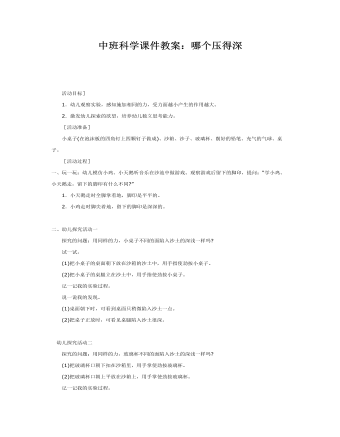
中班科学课件教案:哪个压得深
2.激发幼儿探索的欲望,培养幼儿独立思考能力。 [活动准备] 小桌子(在泡沫板的四角钉上四颗钉子做成)、沙箱、沙子、玻璃杯、削好的铅笔、充气的气球、桌子。 [活动过程]一、玩一玩:幼儿模仿小鸡、小天鹅听音乐在沙池中做游戏。观察游戏后留下的脚印,提问:“学小鸡、小天鹅走,留下的脚印有什么不同?”1.小天鹅走时全脚掌着地,脚印是平平的。2.小鸡走时脚尖着地,留下的脚印是深深的。二、幼儿探究活动一 探究的问题:用同样的力,小桌子不同的面陷入沙土的深浅一样吗? 试一试。(1)把小桌子的桌面朝下放在沙箱的沙土中,用手指使劲按小桌子。(2)把小桌子的桌腿立在沙土中,用手指使劲按小桌子。 记一记我的实验过程。 说一说我的发现。(1)桌面朝下时,可看到桌面只稍微陷入沙土一点。(2)把桌子正放时,可看见桌腿陷入沙土很深。
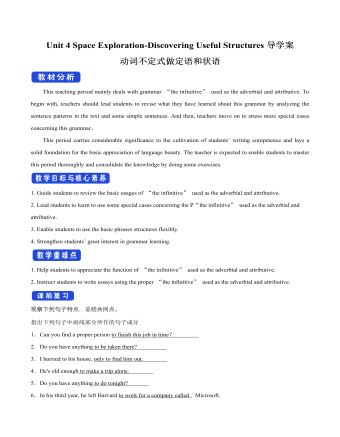
新人教版高中英语必修3Unit 4 Space Exploration-Discovering Useful Structures导学案
【点津】 1.不定式的复合结构作目的状语 ,当不定式或不定式短语有自己的执行者时,要用不定式的复合结构?即在不定式或不定式短语之前加 for +名词或宾格代词?作状语。He opened the door for the children to come in. 他开门让孩子们进来。目的状语从句与不定式的转换 英语中的目的状语从句,还可以变为不定式或不定式短语作状语,从而使句子在结构上得以简化。可分为两种情况: 1?当目的状语从句中的主语与主句中的主语相同时,可以直接简化为不定式或不定式短语作状语。We'll start early in order that/so that we may arrive in time. →We'll start early in order to/so as to arrive in time. 2?当目的状语从句中的主语与主句中的主语不相同时,要用动词不定式的复合结构作状语。I came early in order that you might read my report before the meeting. →I came early in order for you to read my report before the meeting.
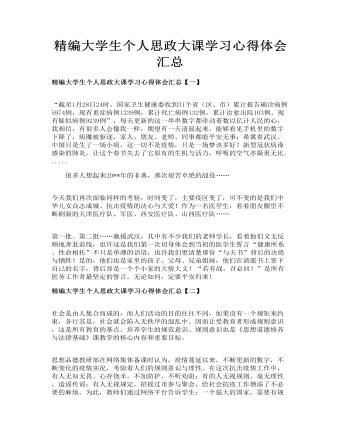
精编大学生个人思政大课学习心得体会汇总
社会是由人集合而成的,而人们活动的目的往往不同,如果没有一个规矩来约束,各行其是,社会就会陷入无秩序的混乱中。因而让受教育者形成规则意识,这是所有教育的基点。培养学生的规范意识、规则意识也是《思想道德修养与法律基础》课教学的核心内容和重要目标。 思想品德教研部在网络集体备课时认为,疫情蔓延以来,不断更新的数字,不断变化的疫情实况,考验着人们的规则意识与理性。在这次抗击疫情工作中,有人无知无畏、心存侥幸,不加防护,不听劝阻;有的人无视规则,毫无理性,造谣传谣;有人无视规定,招摇过市参与聚会,给社会抗疫工作增添了不必要的麻烦。为此,教师们通过网络平台告诉学生:一个强大的国家,需要有规则意识和理性成熟的公民。特别是在疫情防控的关键时期,更不能做无视规则、失去理性的事情。按照上级部门的文件精神和通知要求,各高校都制定了相关规定,比如要求学生不得提前返校,教师要做好延期开学期间线上教学的各项准备工作等规定。大家都要严格遵守这些规定,分清是非,成为具有规则意识和理性的新时代公民。
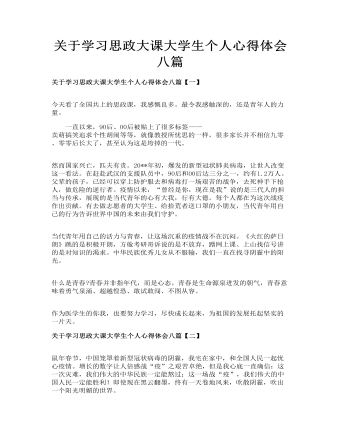
关于学习思政大课大学生个人心得体会八篇
面对来势汹汹的疫情,从猝不及防到全力阻击,从各自为战到同舟共济,国人或勇毅驰援,或坚守岗位,或宅家不出,我们各自用自己的方式共同抗击疫情。中华民族在灾难的考验中凝聚起的正气磅礴的民族精神,百折不挠的民族品格,万众一心的民族情怀定格为无数震撼心灵的画面,砥砺国人奋力前行。 每天,我宅居在家,却和世界息息相通:单位群里天天打卡汇报健康,我打卡之后总会看一看群里那些熟悉的名字,心里莫名的有一种别后无恙各自安好的喜悦;学校领导天天上门查询问候,在我登记健康的时候,我们总会微微一笑,似乎放下了千斤重担;亲朋好友不时微信问候,我们的话题不再只是家长里短,还有武汉加油,中国挺住,我们一定赢……生平第一次,我真实地体会到:无数的人们,无穷的远方,都与我有关。
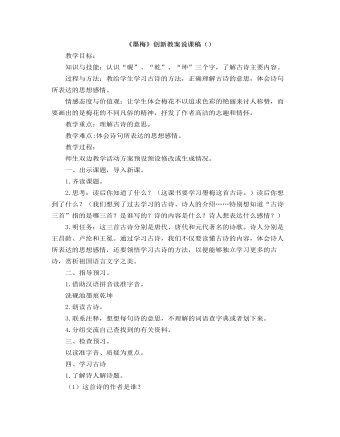
部编人教版四年级下册《古诗词三首》创新教案
二、指导预习。 1.借助汉语拼音读准字音。洗砚池墨痕乾坤2.朗读古诗。3.联系注释,想想每句诗的意思,不理解的词语查字典或者划下来。4.分组交流自己查找到的有关资料。三、检查预习。以读准字音、质疑为重点。四、学习古诗1.了解诗人解诗题。(1)这首诗的作者是谁?(2)《墨梅》作者:元代著名画家王冕。王冕(公元1287——1359)我国元代著名画家。字元章,号煮石山农,诸暨人(今浙江绍兴)。(3)这首诗的题目是什么?(墨梅。这是一首题画诗。墨梅,顾名思义,即为用水墨画的梅花。)(4)从题目上,你知道了什么?还想知道什么?(知道了这首诗写的是水墨画的梅花。想知道这幅梅花图是谁画的?墨梅有什么特点?诗人为什么要写《墨梅》这首诗?要表达自己什么样的感情?)

